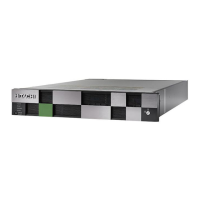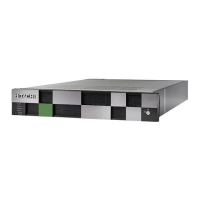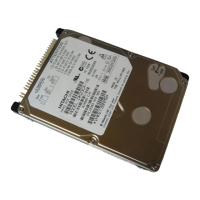Note: To create the pair specifying the P-VOL, specify the actual LDEV
ID (device name) of the P-VOL in the -d option of the paircreate
command.
c. Confirm that the P-VOL and S-VOL pair statuses change to PAIR
(Mirror (RL)).
pairdisplay -g oraHA -fxce -IH0
Group PairVol(L/R) (Port#,TID, LU),Seq#,LDEV#.P/S,Status,
Fence, %,P-LDEV# M CTG JID AP EM E-Seq# E-LDEV# R/W
oraHA dev1(L) (CL1-A-0, 0, 0)311111 2222.P-VOL PAIR
NEVER , 100 4444 - - 0 - - - - L/M
oraHA dev1(R) (CL1-C-0, 0, 0)322222 4444.S-VOL PAIR
NEVER , 100 2222 - - 0 - - - - L/M
pairdisplay -g oraHA -fxce -IH1
Group PairVol(L/R) (Port#,TID, LU),Seq#,LDEV#.P/S,Status,
Fence, %,P-LDEV# M CTG JID AP EM E-Seq# E-LDEV# R/W
oraHA dev1(L) (CL1-C-0, 0, 0)322222 4444.S-VOL PAIR
NEVER , 100 2222 - - 0 - - - - L/M
oraHA dev1(R) (CL1-A-0, 0, 0)311111 2222.P-VOL PAIR
NEVER , 100 4444 - - 0 - - - - L/M
6. Using the alternate path software, add an alternate path from the server
to the S-VOL.
7. Using the alternate path software, resume I/O from the server to the S-
VOL.
Note that I/Os from the server might be resumed automatically.
Related topics
• I/O modes on page 1-12
•
Failure locations on page 6-3
• SIMs related to GAD on page 6-6
Pair condition and recovery: full pool for the P-VOL
Due to a full pool of the P-VOL, a failure that is a GAD pair suspended occurs.
The following table shows the transitions for pair status and I/O mode, the
volumes that are accessible from the server, and the location of the latest
data when you can no longer use the P-VOL due to full pool.
Before failure After failure
Pair status and I/O
mode
Pair status and I/O
mode
Volume
accessible from
the server
Volume
with latest
data
P-VOL S-VOL P-VOL
S-VOL
1
P-VOL S-VOL
PAIR (Mirror
(RL))
PAIR (Mirror
(RL))
PSUE
(Block)
SSWS
(Local)
NG OK S-VOL
Disaster recovery of global-active device
6-19
Hitachi Virtual Storage Platform G1000 Global-Active Device User Guide

